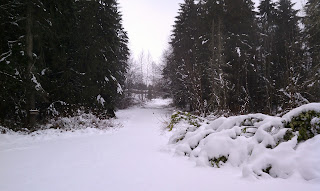Today we had a great day of Amateur Radio.
My friend
Jeff - KO7M came over to help install a new off-center-fed dipole antenna. Until now (since my move), I have suffered with just a 30m Vertical at 0' AGL for all of my Amateur Radio needs.
Today, was the day to fix that.
Jeff arrived about 10:00AM, the weather was clear with some overcast, we ware concerned that the
Great Antenna Gods were not going to be pleased, with an installation that was not properly bathed with enough bad weather to obtain our desired performance. We went ahead with the installation regardless, with the idea we may have to settle for less than optimum performance. But the
Gods smiled on us and provide enough showers to complete the installation with the required anointment.
We used my Tennis Ball Launcher (see
previous post) to put a line into two tall fir trees, about 300 feet apart. With one shot at each end we had antenna support lines up maybe 60 feet, the actual height will be measured in clear weather. We had a lot of branched to snake the support lines around, but with two people the task was not too difficult, it just took time.
The desired feed line locations was about 50 feet from one end. So the counter poise was cut to exactly 23.50937 feet (plus or minus a few feet or so) as maybe needed for 30 meters. We do not know how well this plan will work, but it is what we have, and it fits the space available.
The long wire side of the dipole was cut to exactly, . . . where Jeff stopped un-rolling wire, near the other tree, maybe 200 feet. The center insulator was installed, the long wire and counter poise were attached to the Ladder Line.
Pulling on the end lines took the antenna into the air, and into the near by tree branches and shrubs. With a little work, strong pulls and a small line over the antenna, the limbs were cleared. The antenna was now hanging is a big loop between the trees. A few more strong pulls and it was in place. The feed line location did not work out as expected, but the
Gods were making it difficult to make further adjustments. We picked up our tools and guide ropes, and headed inside as it was now raining.
Jeff had to make one more trip outside in the rain, because we needed to snaked the ladder line into the upper story loft window. Once inside the ladder Line rans across the room, attached to the overhead support beam and onto the radio station area. Later I plan to run coax to just out side the window and into a balun for a match.
By this time, we were glad we were inside, and out of the rain.
Inside and with a quick cut of the ladder line, a twist of the balun terminals on the Antenna Tuner, and the receiver came alive with strong signals being heard, . . . The
Great Antenna Gods must have been pleased.
Now, I agree with the stories that I have heard, "All Good Antennas must be installed in foul weather, if you expect them to perform well" :-)
A very Fun Day.
Now it was time to put my new Propeller QRSS Beacon on the air, and that as a continued report will follow.
--

























